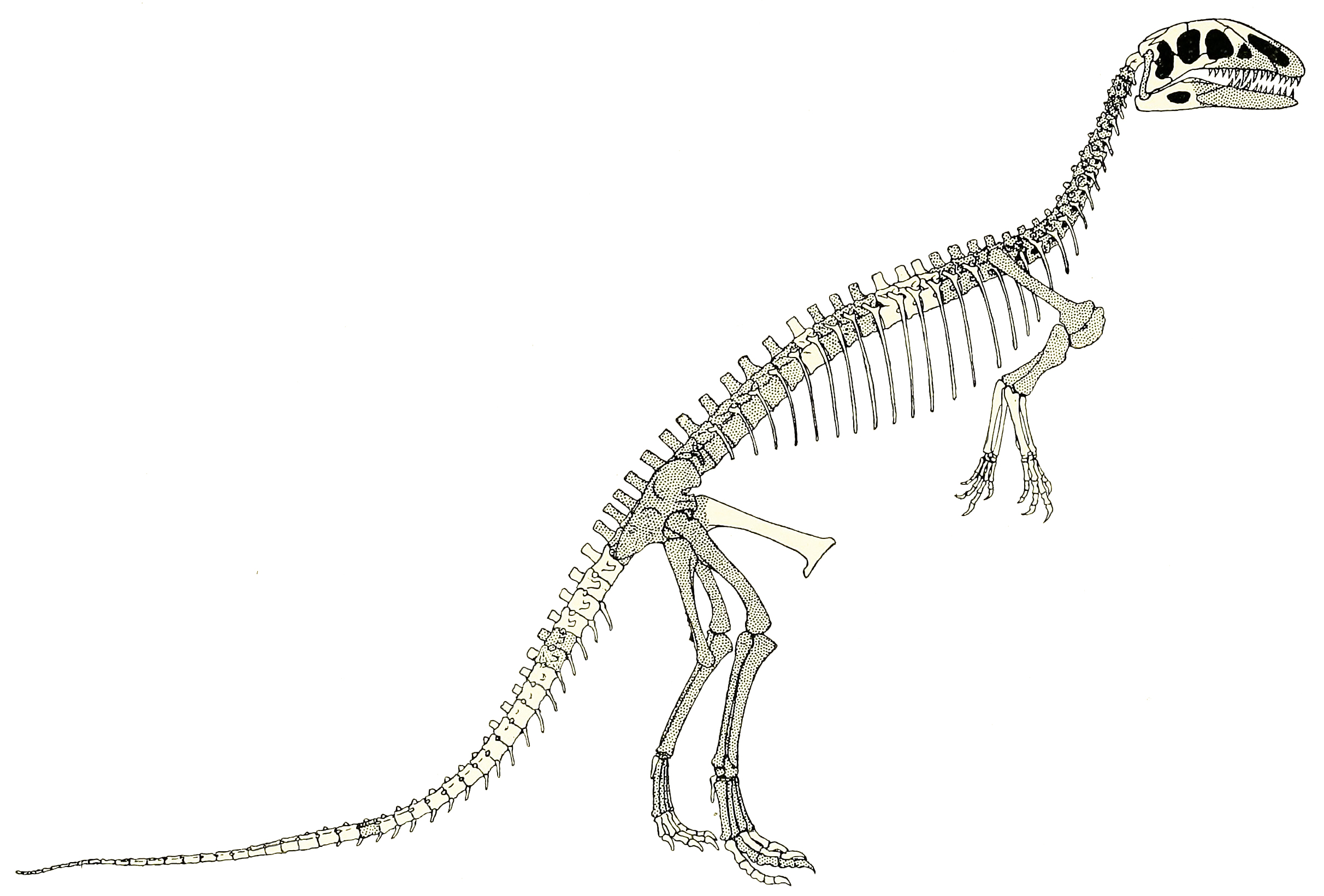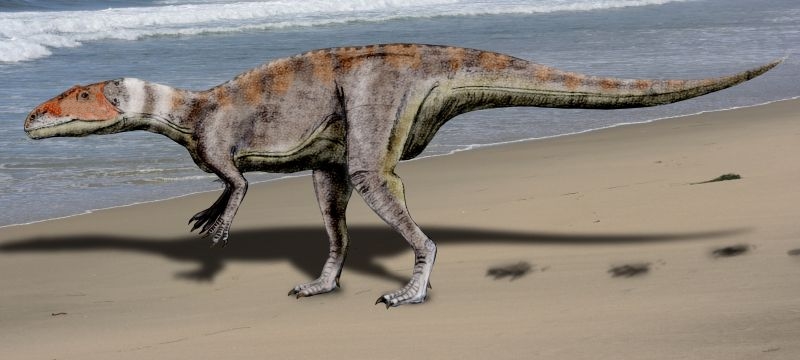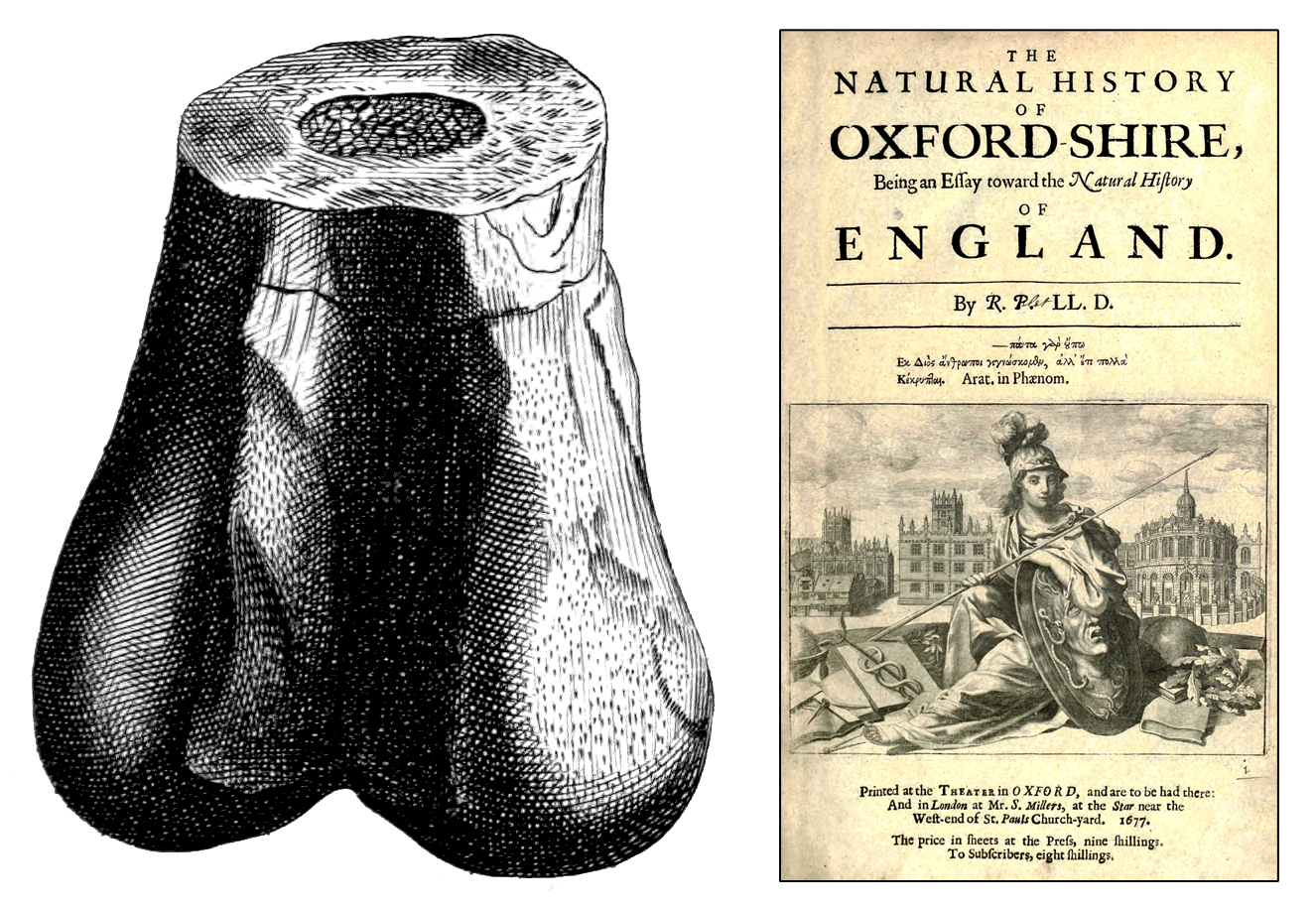|
Megalosaurid
Megalosauridae is a monophyletic family of carnivorous theropod dinosaurs within the group Megalosauroidea. Appearing in the Middle Jurassic, megalosaurids were among the first major radiation of large theropod dinosaurs. They were a relatively primitive group of basal tetanurans containing two main subfamilies, Megalosaurinae and Afrovenatorinae, along with the basal genus ''Eustreptospondylus'', an unresolved taxon which differs from both subfamilies. The defining megalosaurid, ''Megalosaurus bucklandii'', was first named and described in 1824 by William Buckland after multiple finds in Stonesfield, Oxfordshire, UK. ''Megalosaurus'' was the first formally described dinosaur and was the basis for the establishment of the clade Dinosauria. It is also one of the largest known Middle Jurassic carnivorous dinosaurs, with the best-preserved femur at 805 mm and a proposed body mass of around 943 kg. Megalosauridae has mainly been recognized as a European group of dinosa ... [...More Info...] [...Related Items...] OR: [Wikipedia] [Google] [Baidu] |
Duriavenator
''Duriavenator'' is a genus of theropod dinosaur that lived in what is now England during the Middle Jurassic, about 168 million years ago. In 1882, upper and lower jaw bones of a dinosaur were collected near Sherborne in Dorset, and Richard Owen considered the fossils to belong to the species ''Megalosaurus bucklandii'', the first named non-bird dinosaur. By 1964, the specimen was recognised as belonging to a different species, and in 1974 it was described as a new species of ''Megalosaurus'', ''M. hesperis''; the specific name means 'the West' or 'western'. Later researchers questioned whether the species belonged to ''Megalosaurus'', in which many fragmentary theropods from around the world had historically been placed. After examining the taxonomic issues surrounding ''Megalosaurus'', Roger B. J. Benson moved ''M. hesperis'' to its own genus in 2008, ''Duriavenator''; this name means "Dorset hunter". Estimated to have been long and weighed , ''Duriavenator'' has been descr ... [...More Info...] [...Related Items...] OR: [Wikipedia] [Google] [Baidu] |
Torvosaurus
''Torvosaurus'' () is a genus of carnivorous megalosaurid theropod dinosaur that lived approximately 165 to 148 million years ago during the late Middle and Late Jurassic period (Callovian to Tithonian stages) in what is now Colorado, Portugal, Germany, and possibly England, Spain, Tanzania, and Uruguay. It contains two currently recognized species, ''Torvosaurus tanneri'' and ''Torvosaurus gurneyi'', plus a third species from Germany that is currently unnamed. In 1979 the type species ''Torvosaurus tanneri'' was named: it is a large, heavily built, bipedal carnivore, that could grow to a length of about . ''T. tanneri'' was among the largest carnivores of its time, together with '' Epanterias'' and '' Saurophaganax'' (which could both be synonyms for ''Allosaurus''). Specimens referred to ''Torvosaurus gurneyi'' were measured up to long. Based on bone morphology, ''Torvosaurus'' is thought to have had short but very powerful arms. Discovery Fossilized remains of ''Torv ... [...More Info...] [...Related Items...] OR: [Wikipedia] [Google] [Baidu] |
Wiehenvenator
''Wiehenvenator'' is a genus of megalosaurid theropod dinosaur from the Middle Jurassic (Callovian) of north western Germany. The genus contains a single species, ''W. albati''. Discovery and naming In 1998, geologist Friedrich Albat, prospecting for the Landschaftsverband Westfalen-Lippe Museum of Natural History, discovered the remains of a large theropod at the abandoned Pott quarry in the Wiehen Hills near Minden, Westphalia. The remains were discovered within the Ornatenton Formation, a geological formation composed mainly of mudstone, sandstones, and a horizon of carbonate concretions. The fragmentary theropod skeleton, found alongside abundant marine invertebrates and fossilized wood, was excavated between October 1998 and October 2001. At the time of their discovery, the bones were heavily weathered out of the surrounding sediments and are somewhat poorly preserved. The numerous breaks and cracks found in the material risked being destroyed upon removal from the matrix, a ... [...More Info...] [...Related Items...] OR: [Wikipedia] [Google] [Baidu] |
Afrovenator
''Afrovenator'' (; "African hunter") is a genus of megalosaurid theropod dinosaur from the Middle Jurassic Period of northern Africa. Discovery and naming The remains of ''Afrovenator'' were discovered in 1993 in the Tiourarén Formation of the department of Agadez in Niger. The Tiourarén was originally thought to represent the Hauterivian to Barremian stages of the early Cretaceous Period, or approximately 132 to 125 million years ago (Sereno et al. 1994). However, re-interpretation of the sediments showed that they are probably Mid-Jurassic in age, dating ''Afrovenator'' to the Bathonian to Oxfordian stages, between 167 and 161 mya. The sauropod '' Jobaria'', whose remains were first mentioned in the same paper which named ''Afrovenator'', is also known from this formation. ''Afrovenator'' is known from a single relatively complete skeleton, holotype UC OBA 1, featuring most of the skull minus its top (likewise the mandible, or lower jaws, are lacking apart from the ... [...More Info...] [...Related Items...] OR: [Wikipedia] [Google] [Baidu] |
Eustreptospondylus
''Eustreptospondylus'' ( ; meaning "true ''Streptospondylus''") is a genus of megalosaurid Theropoda, theropod dinosaur, from the Oxfordian stage of the Late Jurassic period (some time between 163 and 154 million years ago) in southern England, at a time when Europe was a series of scattered islands (due to tectonic movement at the time which raised the sea-bed and flooded the lowland). Discovery and naming In 1870, workers at the Summertown Brick Pit, just north of Oxford, England, found the skeleton of a theropod. The remains were acquired by the local bookseller James Parker, who brought them to the attention of Oxford Professor John Phillips (geologist), John Phillips. Phillips described the bones in 1871, but did not name them. At the time, the remains represented the most complete skeleton of a large theropod ever found. ''Eustreptospondylus'' is still the most complete of any large Jurassic European theropod. In 1890, the skeleton was bought by Oxford University, a ... [...More Info...] [...Related Items...] OR: [Wikipedia] [Google] [Baidu] |
Poekilopleuron
''Poekilopleuron'' (meaning "varied ribs") is a genus of tetanuran dinosaur, which lived during the middle Bathonian of the Jurassic, about 168 to 166 million years ago. The genus has been used under many different spelling variants, although only one, ''Poekilopleuron'', is valid. The type species is ''P. bucklandii'', named after William Buckland, and many junior synonyms of it have also been erected. Few material is currently known, as the holotype was destroyed in World War II, although many casts of the material still exist. Discovery and naming ''Poekilopleuron'' is a genus of theropod with a long and complex history. The holotype was discovered in July 1835 near La Maladrerie and the genus was named and first described by Jacques Amand Eudes-Deslongchamps in a report published in 1836, based on holotype material that is now destroyed. In 1837, Eudes-Deslongchamps published a more detailed account of this discovery in a monographEudes-Deslongchamps J.-A. (1837) Mémoire s ... [...More Info...] [...Related Items...] OR: [Wikipedia] [Google] [Baidu] |
Magnosaurus
''Magnosaurus'' (meaning 'large lizard') was a genus of theropod dinosaur from the Middle Jurassic of England. It is based on fragmentary remains and has often been confused with or included in ''Megalosaurus''. History and taxonomy In 1923, Friedrich von Huene named ''Megalosaurus nethercombensis'' from a partial skeleton (OUM J12143) from the Bajocian age Middle Jurassic Inferior Oolite, found in the nineteenth century by W. Parker near Nethercomb, north of Sherborne, in Dorset, England. The material included partial dentaries, dorsal and caudal vertebrae, a partial ilium, a partial right pubis, internal casts of the femora, and tibiae, from a possible juvenile individual. Huene interpreted it as a more primitive species of ''Megalosaurus''.von Huene, F. (1923). Carnivorous Saurischia in Europe since the Triassic. ''Bulletin of the Geological Society of America'' 34:449-458. In 1926, he named the tooth species ''Megalosaurus lydekkeri'' for a specimen, BMNH 41352, from the ... [...More Info...] [...Related Items...] OR: [Wikipedia] [Google] [Baidu] |
Dubreuillosaurus
''Dubreuillosaurus'' is a genus of carnivorous dinosaur from the middle Jurassic Period. It is a megalosaurid theropod. Its fossils were found in France. The only named species, ''Dubreuillosaurus valesdunensis'', was originally described as a species of ''Poekilopleuron'', ''Poekilopleuron? valesdunensis'', which is still formally the type species of the genus. It was later renamed ''Dubreuillosaurus valesdunensis'' when, in 2005, Allain came to the conclusion that it was not part of the genus ''Poekilopleuron''. Its type specimen, MNHN 1998-13, is only rivalled in the number of preserved elements in this group by that of ''Eustreptospondylus''. ''Dubreuillosaurus'' is considered to be the sister species of ''Magnosaurus''. It did not show signs of insular dwarfism even though it was uncovered on an island. Discovery and naming In 1994, the mayor of Conteville in Normandy, André Dubreuil, noted that during land rehabilitation of the old quarry of ''Pierre de Caen'', dinosaur b ... [...More Info...] [...Related Items...] OR: [Wikipedia] [Google] [Baidu] |
Megalosaurus Bucklandii
''Megalosaurus'' (meaning "great lizard", from Greek , ', meaning 'big', 'tall' or 'great' and , ', meaning 'lizard') is an extinct genus of large carnivorous theropod dinosaurs of the Middle Jurassic period (Bathonian stage, 166 million years ago) of Southern England. Although fossils from other areas have been assigned to the genus, the only certain remains of ''Megalosaurus'' come from Oxfordshire and date to the late Middle Jurassic. ''Megalosaurus'' was, in 1824, the first genus of non-avian dinosaur to be validly named. The type species is ''Megalosaurus bucklandii'', named in 1827. In 1842, ''Megalosaurus'' was one of three genera on which Richard Owen based his Dinosauria. On Owen's directions a model was made as one of the Crystal Palace Dinosaurs, which greatly increased the public interest for prehistoric reptiles. Over fifty other species would eventually be classified under the genus; at first, this was because so few types of dinosaur had been identified, but the p ... [...More Info...] [...Related Items...] OR: [Wikipedia] [Google] [Baidu] |
Megalosaurus
''Megalosaurus'' (meaning "great lizard", from Greek , ', meaning 'big', 'tall' or 'great' and , ', meaning 'lizard') is an extinct genus of large carnivorous theropod dinosaurs of the Middle Jurassic period (Bathonian stage, 166 million years ago) of Southern England. Although fossils from other areas have been assigned to the genus, the only certain remains of ''Megalosaurus'' come from Oxfordshire and date to the late Middle Jurassic. ''Megalosaurus'' was, in 1824, the first genus of non-avian dinosaur to be validly named. The type species is ''Megalosaurus bucklandii'', named in 1827. In 1842, ''Megalosaurus'' was one of three genera on which Richard Owen based his Dinosauria. On Owen's directions a model was made as one of the Crystal Palace Dinosaurs, which greatly increased the public interest for prehistoric reptiles. Over fifty other species would eventually be classified under the genus; at first, this was because so few types of dinosaur had been identified, but the p ... [...More Info...] [...Related Items...] OR: [Wikipedia] [Google] [Baidu] |
Piveteausaurus
''Piveteausaurus'' (meaning "Jean Piveteau's lizard") is a genus of theropod dinosaur known from a partial skull discovered in the Middle Jurassic Marnes de Dives Formation (stratigraphy), formation of Calvados (department), Calvados, in northern France and lived about 164.7-161.2 million years ago. In 2012 Thomas Holtz gave a possible length of 11 meters (36 feet). History and description The partial braincase that became the type specimen of ''Piveteausaurus'' was first described in 1923 by French Paleontology, paleontologist Jean Piveteau in illustrations and photographs of the specimen (Muséum national d'histoire naturelle, MNHN 1920-7). The braincase is comparable in size to that of a large ''Allosaurus'', and resembles that of another megalosauroid, ''Piatnitzkysaurus'' from Argentina.Rauhut, 2004. Braincase structure of the Middle Jurassic theropod dinosaur ''Piatnitzkysaurus''. Canadian Journal of Earth Science. 41, 1109-1122. Piveteau grouped this partial skull ... [...More Info...] [...Related Items...] OR: [Wikipedia] [Google] [Baidu] |
Megalosauroidea
Megalosauroidea (meaning 'great/big lizard forms') is a superfamily (or clade) of tetanuran theropod dinosaurs that lived from the Middle Jurassic to the Late Cretaceous period. The group is defined as ''Megalosaurus bucklandii'' and all taxa sharing a more recent common ancestor with it than with ''Allosaurus fragilis'' or ''Passer domesticus''. Members of the group include ''Spinosaurus'', ''Megalosaurus'', and ''Torvosaurus''. They are possibly paraphyletic in nature. Classification The name Spinosauroidea is sometimes used in place of Megalosauroidea. The superfamily Spinosauroidea was named in 1915 by Ernst Stromer. It is a synonym of Megalosauroidea in almost all modern phylogenetic analyses, and it is therefore redundant. Spinosauroidea was defined as a clade in 1998 by Paul Sereno as the node clade containing the common ancestor of ''Spinosaurus'' and ''Torvosaurus'' and all its descendants. Thomas Holtz in 2004 defined a branch clade with the same name containing all spec ... [...More Info...] [...Related Items...] OR: [Wikipedia] [Google] [Baidu] |
.jpg)





